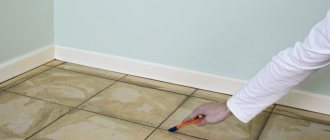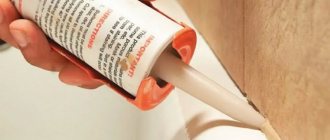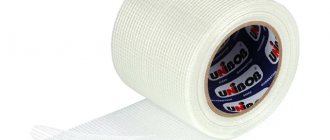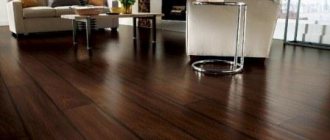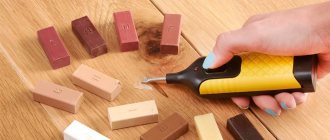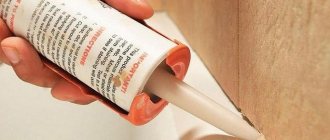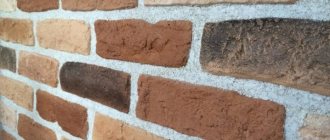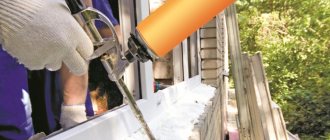Why do you need a sealant?
Laminate is a floor covering in the form of small planks (lamellas) made on the basis of wood-fiber boards. This material consists of the following layers:
- carrier;
- decorative;
- protective (acrylic or melamine).
The topmost layer - protective - is designed to prevent swelling, cracking, and damage to the laminate due to moisture. During installation, the lamellas are connected to each other by joining special locks: grooves and protrusions located along the edges of the elements. These locks, in addition to reliably holding the material on the floor, also perform another practical function: they protect the coating from water penetration inside.
Despite the double mechanism of protection against moisture, if there is a significant accumulation on the surface, it easily seeps into the locks, inside the lamella itself and even under it. The remaining layers of the laminate, except for the protective one, react sharply to such an “invasion”: they begin to warp, crack, and the fibers are greatly deformed. If the room is flooded, the laminate will have to be completely changed: it will instantly lose its attractiveness and swell. But treating the locks with sealant will help seal the cracks in the coating, protecting it from getting wet.
There are huge benefits to installing laminate flooring with sealant. The sealant itself is waterproof, so it reliably closes seams, joints, and provides protection for locking joints, which seriously extends the life of the laminate’s trouble-free operation. In addition, after sealing, the floor covering can withstand higher loads; even heavy furniture will stand on it. The slats will not move when objects are moved across the floor surface.
Other advantages of using sealant:
- the possibility of wet cleaning and the use of detergents;
- Suitable for any type of laminated and parquet boards;
- easy dismantling (as opposed to installation with glue);
- no influence on the characteristics of the coating itself;
- quick drying;
- ease of operation;
- harmlessness of the composition to humans;
- no stains on the floor.
It is also worth noting the increase in the level of sound insulation of the room after applying the sealant: audibility is significantly reduced. It also makes sense to use it where there is constantly high humidity, for example, in the kitchen. If the air in the room is dry and the room is regularly ventilated, you don’t have to seal the locks, although even in such cases the product helps protect the laminate from drying out, deformation and reduces the risk of damage due to flooding by neighbors.
Why do cracks appear in laminate flooring?
A defect may appear due to careless or incorrect installation of lamellas, careless operation, or for natural reasons. Incorrect installation - no gaps
If the lamellas fit too tightly to each other and to the walls, the panels “float” - they narrow or expand in any direction. This occurs due to accumulated stress. They accompany microdeformations that occur with fluctuations in temperature and air humidity. The lack of gaps leads to the fact that the lamellas begin to press each other too much. As a result, the panels change shape and can no longer restore it.
Microdeformations cannot be avoided; to do this, it would be necessary to maintain a strictly constant temperature and humidity in the room. Therefore, the installation technology provides for gaps between the lamellas; this information is in the manufacturers’ recommendations. When installed correctly, stress does not accumulate, because the panels do not press on each other and, with minor expansion, restore their original shape.
Careless installation - weak fastening
A common situation is when the floor is laid hastily and the locks are not tightened. They begin to diverge, the lamellas move. Gaps appear. Poorly secured panels are easily deformed. Defects appear that will be difficult to eliminate.
Water ingress
If wooden boards are heavily and/or systematically wet, their geometry may change irreversibly. You need to be wary not only of domestic floods caused by neighbors above, but also of minor leaks (for example, those that occur when watering flowers).
Seasonal changes in air humidity
The lamellas expand in all directions at high humidity and narrow at low humidity. The absorption and evaporation of moisture occurs unevenly, which can cause the coating to become deformed. The gaps will be especially noticeable if the boards were laid incorrectly or got wet.
Composition of sealants
After drying, the sealant is an elastic rubber seal for laminate seams. Accordingly, it contains components that provide strength, the ability to withstand vibration, and dynamic loads. The basis of the sealant is silicone or acrylic, which meets all the specified requirements.
The products also contain various plasticizers, viscosity-reducing organic extenders, and mineral compounds. Other possible components of sealants are:
- antiseptics and fungicides;
- quartz flour;
- chalk.
Colored sealants additionally contain coloring agents (pigments). They are designed for specific laminate shades and most often come in grey, dark brown, wood tones. There are also transparent, colorless products on sale that are suitable for any type of material and are practically invisible on it.
Properties and characteristics of laminate sealant
Unlike glue, sealants do not glue the lamellas together; they act as a kind of rubber seal. In addition to the highly elastic composition, the products are distinguished by the following properties:
- strength, durability;
- resistance to various external influences;
- ability to withstand humidity and temperature changes;
- hiding cracks and joints between planks.
Many sealants are applied straight from a tube, but some will require a special caulk gun to work with. Due to the lack of strong adhesiveness, you can wipe off drops of sealant, as well as remove its excess without any problems.
Is a sealant justified in practice (When a sealant may be needed)
The use of sealant is justified if the laminate without moisture or water-resistant qualities is laid in a place where it may periodically come into contact with water. This could be the kitchen or hallway. In other cases, processing the laminate seams will only be a safety net. Even if you spill water on the laminate and wipe it right away, nothing bad will happen to it. And if there is a flood in your apartment, no sealant will save the laminate. Insurance is voluntary and requires additional costs. For a room of 50 square meters you will have to spend from 2000 to 3000 rubles on processing the seams.
The sealant is applied to the top tenon of the laminate. Lock joints are not processed because this may prevent the panels from being tightly secured.
In modern renovations, craftsmen refuse to use glue to attach the floor covering to the base. Laminate manufacturers talk about treating seams, but they say that this is not necessary with a high-quality laminate and leave the decision to use a sealant to the customer's choice. It is enough to choose the right laminate for a specific location and care for it according to the manufacturer’s instructions.
Types of compositions for processing laminate locks
There are several types of sealants on the market: gels, silicone, acrylic compounds. Also, other means that do not belong to sealants are used for laminate joints: wax pencils, grouts, mastics, “liquid cork”.
Sealant-gel for laminate
Such sealants are packaged in tubes of 125-150 g and look like simple toothpaste. They are gel-like in consistency, looking like a colorless or matte white jelly. They are easy to work with, making them very popular in home repairs.
Gels can be used at temperatures from -20... to +40 degrees, they are waterproof, elastic, and do not react to ultraviolet radiation. After applying them in a thin layer to the ridges of the locks, the lamellas are immediately joined to the already laid parts. Excess gel is immediately removed with a napkin, and as it dries, a plastic spatula is used for this purpose. Gel sealants can be used even in unheated rooms, since the floor covering will not lose its strength and visual appeal.
Silicone sealants
Such funds are the most in demand. They are based on silicone rubber, as well as adhesive primers, plasticizers, antifungal substances and vulcanizers - hardening accelerators. Silicone sealants are thicker than gel sealants and resemble a white translucent cream. There are also colored products available in different shades.
Silicone has excellent elasticity, so the floor covering will not deteriorate even from strong vibration. Sealants are safe for health, odorless, and do not cause stains on the surface. After drying, the floor will be reliably protected from moisture penetration. If you need to replace one lamella, it can be easily separated from the surface, because silicone does not glue the locks together.
Acrylic sealants
Among acrylic sealing compounds, colored ones are most often found. Their base is acrylic; additives may also include calcium carbonate, plasticizers, and titanium dioxide. Such sealants can be used not only for installing laminate flooring, but also for sealing chips, cracks, and other coating defects.
Acrylic makes the floor no less durable and impermeable to water than silicone. Such sealants are characterized by vapor permeability, resistance to UV radiation, and aesthetically pleasing seams. After drying, it is better to paint the joints, if necessary. Unfortunately, acrylic compounds can only be used in heated rooms, since they are not frost-resistant.
Wax pencil for laminate
This product helps repair chips and scratches. With significant mechanical impact, unpleasant defects appear on the panels. The solution to this problem is to replace the damaged panel. But this option is suitable if the flooring was purchased with a reserve. Otherwise, the shade in different batches of the same manufacturer may differ. Therefore, using a laminate pencil is the most acceptable option.
For restoration, you need to choose the right shade. Laminate has the texture of natural wood, so several shades are available. It all depends on the scale of the scratch. We also recommend reading how to restore parquet with your own hands.
Laminate restoration technology:
- The damage is cleaned of fine dust and dirt. It is important to ensure that the sides of the scratch have an even cut.
- The product is applied to the defect. If several shades are used, then hard wax is applied as a continuation of the pattern on the canvases.
- Laminate repairs are completed by polishing the surface with a dry cloth.
Such manipulations will help against small and shallow scratches. For large defects, mastics and wax sealants are used.
The material is selected to match the main color of the panel. It’s good if the chipped part remains. This will make the repair somewhat easier. A laminate product with wax is applied to the defect and the broken area is glued. The excess is removed. The composition hardens and is polished.
Super-hard wax is also available on sale. This composition is melted before use. Then it is applied to the damaged areas and polished after hardening.
An important point when choosing a kit for repairs at home is whether the surface will be glossy or matte. Even with small defects, the resulting result will spoil the appearance. One can only imagine a matte stain on a glossy floor. It will stand out significantly from the general background.
Most popular brands
You can find sealants from different manufacturers on sale. In order to choose the right product and purchase the best option, you need to pay attention to the factors that determine quality:
- absence of unpleasant odor and harmful substances in the composition;
- ease of removal from the surface after drying;
- short polymerization times (sealant that does not harden for a long time will seriously complicate repairs);
- convenient method of application;
- moderate cost (depending on the user’s budget).
Below are the most well-known sealants that are well suited for laminate and can be used during its installation.
Click Guard
Click Guard sealant is manufactured in Germany. It can be used for laminate of any class, price category, for all types of locks and protective coatings. Thanks to the elongated spout on the tube, applying the sealant is easy; no additional tools are required. The product dries in 15 minutes, its excess can be easily removed from the floor covering. One package of sealant is consumed per 7-10 square meters of floor.
Click Protect
This product is made in Sweden. The composition is moisture-resistant, colorless, and is widely used when laying any types of laminate and parquet. Thanks to its economical consumption (15 square tube) and quick polymerization (half an hour), the sealant is highly respected among professionals.
Soudal
This colored acrylic sealant is suitable for installing laminate flooring, sealing cracks, chips, cracks, and scratches on this material, as well as for restoring old coatings. It is completely safe, odorless, and comes in different color variations. Other advantages include the possibility of using “floating” coatings for laying, a high level of adhesion, and ease of removal of excess. To work, you will have to purchase a special gun, without which application will be difficult.
Roci AquaStop
This wax sealant with the addition of acrylic is intended for laying lamellas whose side surfaces do not have a protective film. Creates a reliable, strong connection between locks, eliminates creaking of the floor covering, and prevents moisture penetration. The sealant can be applied with a regular brush.
MasterFix
Masterfix sealant is produced in Russia. It has a low price and high quality, is universal, suitable for all types of laminate, and has powerful water-repellent properties.
Quick Step
Quick Step sealant from Belgium is designed specifically for additional protection of laminate flooring from moisture. It allows you to install this flooring even in the bathroom. The sealant is elastic, completely transparent, and hardens quickly. The gel is consumed moderately: a tube is enough for 10 square meters.
Bostik Clic Protect
“Bostik” is a French sealant for laminate flooring, sold in 125 ml tubes. It provides long-term protection against moisture penetration into the area of joints between planks, is suitable for laying parquet using the floating method, is colorless and does not leave stains.
Homax
Homax brand sealant was created in Germany using the latest technologies. It is available in different colors (for example, “light oak”), has an environmentally friendly composition, and is completely safe for people. The sealant has a high degree of adhesion to wood, laminate, is moisture resistant, and ensures a reliable connection of elements.
"Titanium"
The Titan product is a colorless gel for laminate joints. Allows you to make the seams durable and moisture-resistant, dries in 15-20 minutes, and is used economically. Among the disadvantages is an unpleasant odor, which completely disappears after polymerization.
Application technology
Typically, seams are treated with sealant when laying new laminate flooring. It is also recommended to do sealing during the restoration of the old coating with parallel sealing of chips, cracks, and other defects. The sealant is applied without gaps, completely. Tips for doing the job:
- it is necessary to correctly form the joint so that the seam between the individual elements does not limit freedom of movement;
- The sealant should not get on the bottom or top of the lamellas - it is applied only to the sides, otherwise the risk of seam rupture under load increases;
- When filling wide joints, it is advisable to use cellophane covers on the front side, which will protect the elements from sealant.
To apply the product, take a tube with a sharp tip or a bottle inserted into a gun. The tip of the package is placed in the groove of the lamella at an angle of 45 degrees, and the composition is squeezed out in an even strip. When working with a mounting gun, it is much easier to achieve uniformity of the layer than when using tubes.
Excess sealant is removed with a narrow spatula, previously moistened with water. After that, the planks are connected, and a small amount of sealant protrudes onto the surface: it also needs to be removed, but only after 15-30 minutes, when polymerization occurs. It is better to use a plastic spatula for this; a metal one can leave scratches.
If the old coating is being restored, the previous layer of sealant (if any) must be removed in advance. This can be done mechanically: by picking it up with a spatula and tearing it off with a strip. Remains of sealant must be washed with a solvent. Before coating the laminate with a new product, the elements must be wiped with a soft cloth.
Sealing the deformation gap
The sealant will help to reliably seal the expansion joints that are created after laying the covering along the walls. Without this, moisture may seep inside, and all efforts to seal the side parts of the slats will be in vain. The work is carried out in the following stages:
- wipe the laminate with a damp cloth on the side that will be near the wall;
- seal the deformation gap with construction tape so that the product does not get on the front side of the laminate;
- fill the seam with sealant, smooth it with a rubber spatula immediately after application;
- Remove the tape and carefully wipe the finished seam with a damp cloth.
When installing, do not fasten the lamellas too tightly, otherwise they may warp during operation. The locks must be latched so that they do not move freely later.
Despite the slow speed of work when using sealant, the quality of the floor covering will be much higher, the laminate will last longer and without complaints.
Removing wax from laminate flooring
Often holidays and aromatherapy are accompanied by the use of lit candles. If dripping wax gets on the linoleum, removing it will not be difficult. What should you do if it gets on a laminate impregnated with wax?
There are several ways:
- You can remove wax from the laminate if it has not yet hardened using a simple soft cloth or napkin.
- If the drops are hard, then carefully remove them with a plastic knife. The area is wiped and treated with a special product.
- Heat the drop with a hair dryer and remove the candle wax with a soft cloth.
- Using an iron, point-to-point heat a drop through a napkin. When heated, it will be partially absorbed into the paper. Remove the remainder with the same napkin. Finally, the laminate is treated with special care products.
DIY wax removal is easy to do. The following should not be used in this process:
- Acetone, which when combined with wax forms stains.
- Abrasive cleaning products. They will leave small scratches.
- Metal sponges and scrapers also deform the protective layer.
Laminate is a decent floor covering. Its service life is directly related to how it is cared for. For zealous owners, this type of finishing will last a long time, even if the family has children and pets. Video: Wax crayons and varnish for chips and cracks
